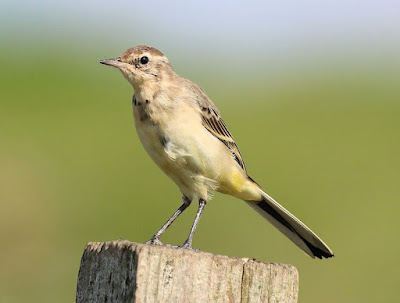Our nearby fields are awash with cut grass drying out in readiness for winter storage. Summer finally arrived for now. Hay and silage are two common methods of preserving grass for livestock feed. Hay is made by cutting and drying grass while silage is made by fermenting the gather cuttings in an airtight container.
Tractors fly across local fields as local farmers enjoy a long spell of warm sunny weather after the tortuous winter and equally wet spring that stopped their work for days at a time and caused a redrawing of plans. At last, fields of stunted maize gain height towards their 8/10 feet goal. Temperature is paramount for maize where the seed needs soil temperatures above 10°C to grow, temperatures that we rarely reached throughout a long, cold spring.
Maize
This is a quiet time for ringing but since my last post I too have been out and about in the sunshine, camera, long lens and bins at the ready.
Another Marsh Harrier came along, a silent dip and dive across the fields, looking for that elusive prize, a mammal scurrying through layered green. On its way it went, almost reluctantly in a south westerly direction as if drawn by some unknown force of nature.
Mid week saw the first of the returning Yellow Wagtails, a single juvenile amongst the dozens of Pied Wagtails.
Yellow Wagtail
Pied Wagtail
Pied Wagtail
And now I wait for comments about the grey wagtail, a Yellow Wagtail that is quite grey but assuredly a Western Yellow Wagtail, Motacilla flava, a scarce breeding species of the Fylde area that is so scarce it cannot decline further but simply disappear into the annals of history. But, always good to see, hear and recall that soft “seep seep”.
Water at the feeding station attracted Starlings in their juvenile variations, a mixed coat of pinky grey softness with a layer of spotted insulation that for all the world looked as if it had been stuck on a belly as an afterthought. For students of bird moult a Starling is one to tax a ringer’s entry of “age” on the BTO's DemOn database. Good subjects for a camera lens but thank goodness we don’t catch any of the noisy, forever squawking things.
Starling
Starling
Little Egrets begin to build in autumn numbers while Grey Herons subside into single sightings, two species which one might think can sustain their respective populations but seemingly not when the heron is now “scarce” and the egret “common”.
Grey Heron
The feeding station is well situated to exploit the bokeh of the telephoto lens, where shades of vegetation green, brown and ochre compete with a spot of blue sky for an out of focus backdrop.
Meadow Pipit
Linnet
That’s me for a day or two. Thursday Friday we have Brett in to paint our kitchen diner - spend some dosh before our new Government, “party of the workers” take it all from us.
Politicians tell lies to win over gullible fools so as to win elections. Who Knew?
See you soon folks.








































4 comments:
I hope that you are also looking for the insects with all this hay-making going on!!
Wagtails always confuse me I never know which one it is and I do not see them often enough to get my ha around them.
Great set of photos and thanks for the comment. Keep cool it is ridiculous here edging on 40C almost daily, certainly above 30 every day. The garden is struggling and the birds are not happy either. Cheers Diane
We (and the farmers) are elated that you can finally welcome the arrival of Summer. It's wonderful to see them make hay while the sun shines.
Again, your image of the harrier has me already wishing for our first Autumn migrants. Sigh. Another month - or two.
For some reason, the starlings have found somewhere else to raise their noisy youngsters. Our yard squirrels, cardinals and dove appreciate it.
The Meadow Pipit portrait did, indeed, turn out very lovely.
We continue to try and avoid "breaking news" as the silly season attempts to beat common sense into submission. The swamp offers solace.
Gini and I hope you and Sue enjoy your brief Summer.
Some familiar birds there. Sad news that herons are declining - they were a special - and regular - part of my childhood on the Somerset Levels.
Stewart M - Melbourne
great info
Post a Comment